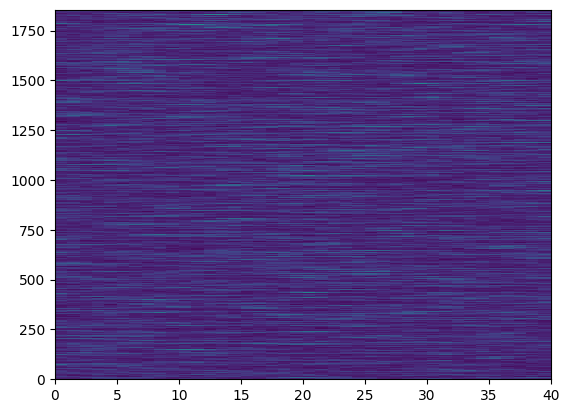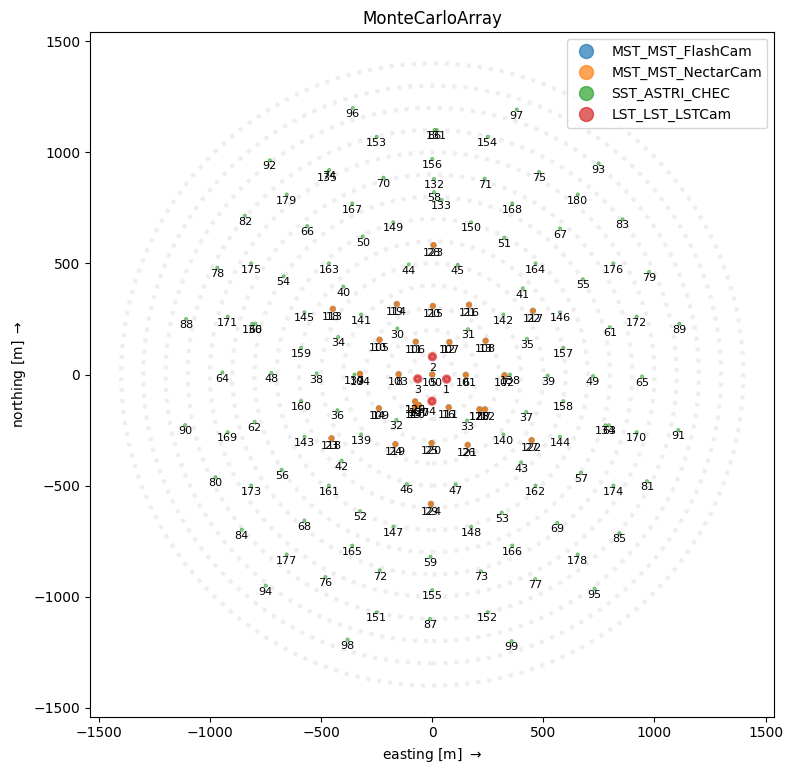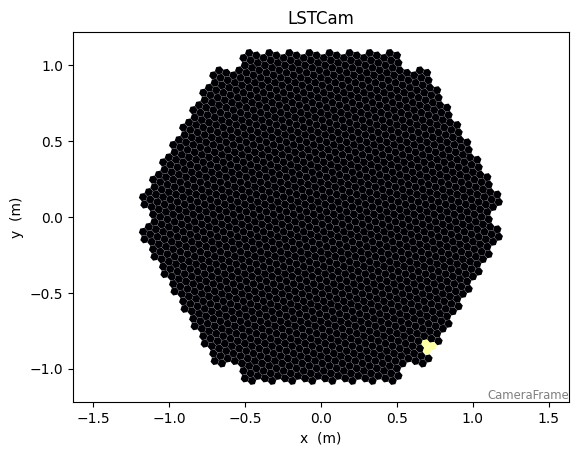Getting Started with ctapipe¶
This hands-on was presented at the Paris CTA Consoritum meeting (K. Kosack)
Part 1: load and loop over data¶
[1]:
from ctapipe.io import EventSource
from ctapipe import utils
from matplotlib import pyplot as plt
import numpy as np
%matplotlib inline
[2]:
path = utils.get_dataset_path("gamma_prod5.simtel.zst")
[3]:
source = EventSource(path, max_events=5)
for event in source:
print(event.count, event.index.event_id, event.simulation.shower.energy)
0 4009 0.07287972420454025 TeV
1 5101 1.7454713582992554 TeV
2 5103 1.7454713582992554 TeV
3 5104 1.7454713582992554 TeV
4 5105 1.7454713582992554 TeV
[4]:
event
[4]:
ctapipe.containers.ArrayEventContainer:
index.*: event indexing information with default None
r0.*: Raw Data with default None
r1.*: R1 Calibrated Data with default None
dl0.*: DL0 Data Volume Reduced Data with default None
dl1.*: DL1 Calibrated image with default None
dl2.*: DL2 reconstruction info with default None
simulation.*: Simulated Event Information with default None
with type <class
'ctapipe.containers.SimulatedEventContainer'>
trigger.*: central trigger information with default None
count: number of events processed with default 0
pointing.*: Array and telescope pointing positions with
default None
calibration.*: Container for calibration coefficients for the
current event with default None
mon.*: container for event-wise monitoring data (MON)
with default None
muon.*: Container for muon analysis results with default
None
[5]:
event.r1
[5]:
ctapipe.containers.R1Container:
tel[*]: map of tel_id to R1CameraContainer with default
None
[6]:
for event in EventSource(path, max_events=5):
print(event.count, event.r1.tel.keys())
0 dict_keys([9, 14, 104])
1 dict_keys([26, 27, 29, 47, 53, 59, 69, 73, 121, 122, 124, 148, 162, 166])
2 dict_keys([82, 92, 175, 179])
3 dict_keys([17, 26, 27, 29, 43, 47, 53, 57, 69, 112, 121, 122, 124, 125, 128, 140, 144, 148, 162, 166])
4 dict_keys([3, 4, 8, 9, 14, 15, 23, 24, 25, 29, 32, 36, 42, 46, 52, 56, 103, 104, 109, 110, 118, 119, 120, 126, 127, 129, 130, 137, 139, 143, 161])
[7]:
event.r0.tel[3]
[7]:
ctapipe.containers.R0CameraContainer:
waveform: numpy array containing ADC samples(n_channels,
n_pixels, n_samples) with default None
[8]:
r0tel = event.r0.tel[3]
[9]:
r0tel.waveform
[9]:
array([[[432, 413, 395, ..., 382, 387, 382],
[419, 420, 428, ..., 392, 396, 405],
[381, 392, 413, ..., 375, 387, 387],
...,
[391, 384, 385, ..., 379, 395, 404],
[370, 376, 388, ..., 391, 383, 383],
[393, 411, 413, ..., 406, 392, 396]],
[[413, 396, 398, ..., 397, 401, 395],
[392, 407, 403, ..., 403, 388, 399],
[405, 403, 393, ..., 393, 400, 409],
...,
[399, 406, 407, ..., 391, 405, 397],
[401, 399, 396, ..., 395, 400, 388],
[399, 393, 403, ..., 395, 407, 401]]], dtype=uint16)
[10]:
r0tel.waveform.shape
[10]:
(2, 1855, 40)
note that this is (\(N_{channels}\), \(N_{pixels}\), \(N_{samples}\))
[11]:
plt.pcolormesh(r0tel.waveform[0])
[11]:
<matplotlib.collections.QuadMesh at 0x7f07b553c700>

[12]:
brightest_pixel = np.argmax(r0tel.waveform[0].sum(axis=1))
print(f"pixel {brightest_pixel} has sum {r0tel.waveform[0,1535].sum()}")
pixel 1831 has sum 15824
[13]:
plt.plot(r0tel.waveform[0,brightest_pixel], label="channel 0 (high-gain)")
plt.plot(r0tel.waveform[1,brightest_pixel], label="channel 1 (low-gain)")
plt.legend()
[13]:
<matplotlib.legend.Legend at 0x7f07b55f2130>

[14]:
from ipywidgets import interact
@interact
def view_waveform(chan=0, pix_id=brightest_pixel):
plt.plot(r0tel.waveform[chan, pix_id])
try making this compare 2 waveforms
Part 2: Explore the instrument description¶
This is all well and good, but we don’t really know what camera or telescope this is… how do we get instrumental description info?
Currently this is returned inside the event (it will soon change to be separate in next version or so)
[15]:
subarray = source.subarray
[16]:
subarray
[16]:
SubarrayDescription(name='MonteCarloArray', n_tels=180)
[17]:
subarray.peek()

[18]:
subarray.to_table()
[18]:
| tel_id | name | type | pos_x | pos_y | pos_z | camera_name | optics_name | camera_index | optics_index | tel_description |
|---|---|---|---|---|---|---|---|---|---|---|
| m | m | m | ||||||||
| int16 | str5 | str3 | float32 | float32 | float32 | str9 | str5 | int64 | int64 | str17 |
| 1 | LST | LST | -20.643 | -64.817 | 34.3 | LSTCam | LST | 2 | 1 | LST_LST_LSTCam |
| 2 | LST | LST | 79.993996 | -0.768 | 29.4 | LSTCam | LST | 2 | 1 | LST_LST_LSTCam |
| 3 | LST | LST | -19.396 | 65.2 | 31.0 | LSTCam | LST | 2 | 1 | LST_LST_LSTCam |
| 4 | LST | LST | -120.033 | 1.151 | 33.1 | LSTCam | LST | 2 | 1 | LST_LST_LSTCam |
| 5 | MST | MST | -0.017 | -0.001 | 24.35 | FlashCam | MST | 1 | 2 | MST_MST_FlashCam |
| 6 | MST | MST | -1.468 | -151.221 | 31.0 | FlashCam | MST | 1 | 2 | MST_MST_FlashCam |
| 7 | MST | MST | -3.1379998 | -325.245 | 39.0 | FlashCam | MST | 1 | 2 | MST_MST_FlashCam |
| 8 | MST | MST | 1.4339999 | 151.22 | 25.0 | FlashCam | MST | 1 | 2 | MST_MST_FlashCam |
| 9 | MST | MST | 3.1039999 | 325.243 | 23.5 | FlashCam | MST | 1 | 2 | MST_MST_FlashCam |
| ... | ... | ... | ... | ... | ... | ... | ... | ... | ... | ... |
| 171 | ASTRI | SST | 260.0 | 920.0 | 45.0 | CHEC | ASTRI | 0 | 0 | SST_ASTRI_CHEC |
| 172 | ASTRI | SST | 260.0 | -920.0 | 65.0 | CHEC | ASTRI | 0 | 0 | SST_ASTRI_CHEC |
| 173 | ASTRI | SST | -500.0 | 815.0 | 15.0 | CHEC | ASTRI | 0 | 0 | SST_ASTRI_CHEC |
| 174 | ASTRI | SST | -500.0 | -815.0 | 75.0 | CHEC | ASTRI | 0 | 0 | SST_ASTRI_CHEC |
| 175 | ASTRI | SST | 500.0 | 815.0 | 45.0 | CHEC | ASTRI | 0 | 0 | SST_ASTRI_CHEC |
| 176 | ASTRI | SST | 500.0 | -815.0 | 53.0 | CHEC | ASTRI | 0 | 0 | SST_ASTRI_CHEC |
| 177 | ASTRI | SST | -810.0 | 655.0 | 12.0 | CHEC | ASTRI | 0 | 0 | SST_ASTRI_CHEC |
| 178 | ASTRI | SST | -810.0 | -655.0 | 68.0 | CHEC | ASTRI | 0 | 0 | SST_ASTRI_CHEC |
| 179 | ASTRI | SST | 810.0 | 655.0 | 20.0 | CHEC | ASTRI | 0 | 0 | SST_ASTRI_CHEC |
| 180 | ASTRI | SST | 810.0 | -655.0 | 41.0 | CHEC | ASTRI | 0 | 0 | SST_ASTRI_CHEC |
[19]:
subarray.tel[2]
[19]:
TelescopeDescription(type='LST', optics_name='LST', camera_name='LSTCam')
[20]:
subarray.tel[2].camera
[20]:
CameraDescription(name=LSTCam, geometry=LSTCam, readout=LSTCam)
[21]:
subarray.tel[2].optics
[21]:
OpticsDescription(name=LST, size_type=LST, reflector_shape=PARABOLIC, equivalent_focal_length=28.00 m, effective_focal_length=29.31 m, n_mirrors=1, mirror_area=386.73 m2)
[22]:
tel = subarray.tel[2]
[23]:
tel.camera
[23]:
CameraDescription(name=LSTCam, geometry=LSTCam, readout=LSTCam)
[24]:
tel.optics
[24]:
OpticsDescription(name=LST, size_type=LST, reflector_shape=PARABOLIC, equivalent_focal_length=28.00 m, effective_focal_length=29.31 m, n_mirrors=1, mirror_area=386.73 m2)
[25]:
tel.camera.geometry.pix_x
[25]:
[26]:
tel.camera.geometry.to_table()
[26]:
| pix_id | pix_x | pix_y | pix_area |
|---|---|---|---|
| m | m | m2 | |
| int64 | float64 | float64 | float64 |
| 0 | 0.0 | 0.0 | 0.002079326892271638 |
| 1 | -0.03779670120038493 | -0.03273242903676833 | 0.002079326892271638 |
| 2 | -0.047245474963293455 | 0.01636666208397624 | 0.002079326892271638 |
| 3 | -0.009448773762908525 | 0.04909909112074457 | 0.002079326892271638 |
| 4 | 0.03779670120038493 | 0.03273242903676833 | 0.002079326892271638 |
| 5 | 0.047245474963293455 | -0.01636666208397624 | 0.002079326892271638 |
| 6 | 0.009448773762908525 | -0.04909909112074457 | 0.002079326892271638 |
| 7 | -0.07559330728842002 | -0.06546483976983582 | 0.002079326892271638 |
| 8 | -0.08504208105132854 | -0.016365748649091242 | 0.002079326892271638 |
| ... | ... | ... | ... |
| 1845 | -0.7086768843206072 | 0.9328863284767507 | 0.002079326892271638 |
| 1846 | -0.6708803327659517 | 0.9656188254531994 | 0.002079326892271638 |
| 1847 | 0.45356483600883185 | 1.0801754621151207 | 0.002079326892271638 |
| 1848 | 0.5008102444966699 | 1.0638087511987853 | 0.002079326892271638 |
| 1849 | 1.1622417344092089 | 0.14728906047502402 | 0.002079326892271638 |
| 1850 | 1.1716905074681288 | 0.09818997301244675 | 0.002079326892271638 |
| 1851 | 0.7086768843206072 | -0.9328863284767507 | 0.002079326892271638 |
| 1852 | 0.6708803327659517 | -0.9656188254531994 | 0.002079326892271638 |
| 1853 | -0.45356483600883185 | -1.0801754621151207 | 0.002079326892271638 |
| 1854 | -0.5008102444966699 | -1.0638087511987853 | 0.002079326892271638 |
[27]:
tel.optics.mirror_area
[27]:
[28]:
from ctapipe.visualization import CameraDisplay
[29]:
disp = CameraDisplay(tel.camera.geometry)

[30]:
disp = CameraDisplay(tel.camera.geometry)
disp.image = r0tel.waveform[0,:,10] # display channel 0, sample 0 (try others like 10)

** aside: ** show demo using a CameraDisplay in interactive mode in ipython rather than notebook
Part 3: Apply some calibration and trace integration¶
[31]:
from ctapipe.calib import CameraCalibrator
[32]:
calib = CameraCalibrator(subarray=subarray)
[33]:
for event in EventSource(path, max_events=5):
calib(event) # fills in r1, dl0, and dl1
print(event.dl1.tel.keys())
dict_keys([9, 14, 104])
dict_keys([26, 27, 29, 47, 53, 59, 69, 73, 121, 122, 124, 148, 162, 166])
dict_keys([82, 92, 175, 179])
dict_keys([17, 26, 27, 29, 43, 47, 53, 57, 69, 112, 121, 122, 124, 125, 128, 140, 144, 148, 162, 166])
dict_keys([3, 4, 8, 9, 14, 15, 23, 24, 25, 29, 32, 36, 42, 46, 52, 56, 103, 104, 109, 110, 118, 119, 120, 126, 127, 129, 130, 137, 139, 143, 161])
[34]:
event.dl1.tel[3]
[34]:
ctapipe.containers.DL1CameraContainer:
image: Numpy array of camera image, after waveform
extraction.Shape: (n_pixel) with default None as
a 1-D array with dtype float32
peak_time: Numpy array containing position of the peak of
the pulse as determined by the extractor. Shape:
(n_pixel, ) with default None as a 1-D array
with dtype float32
image_mask: Boolean numpy array where True means the pixel
has passed cleaning. Shape: (n_pixel, ) with
default None as a 1-D array with dtype bool
is_valid: True if image extraction succeeded, False if
failed or in the case of TwoPass methods, that
the first pass only was returned. with default
False
parameters: Image parameters with default None with type
<class
'ctapipe.containers.ImageParametersContainer'>
[35]:
dl1tel = event.dl1.tel[3]
[36]:
dl1tel.image.shape # note this will be gain-selected in next version, so will be just 1D array of 1855
[36]:
(1855,)
[37]:
dl1tel.peak_time
[37]:
array([27.381046, 17.746258, 18.80205 , ..., 11.64868 , 31.961287,
29.717525], dtype=float32)
[38]:
CameraDisplay(tel.camera.geometry, image=dl1tel.image)
[38]:
<ctapipe.visualization.mpl_camera.CameraDisplay at 0x7f07b616b100>

[39]:
CameraDisplay(tel.camera.geometry, image=dl1tel.peak_time)
[39]:
<ctapipe.visualization.mpl_camera.CameraDisplay at 0x7f07b5793340>

Now for Hillas Parameters
[40]:
from ctapipe.image import hillas_parameters, tailcuts_clean
[41]:
image = dl1tel.image
mask = tailcuts_clean(tel.camera.geometry, image, picture_thresh=10, boundary_thresh=5)
mask
[41]:
array([False, False, False, ..., False, False, False])
[42]:
CameraDisplay(tel.camera.geometry, image=mask)
[42]:
<ctapipe.visualization.mpl_camera.CameraDisplay at 0x7f07b60ad100>

[43]:
cleaned = image.copy()
cleaned[~mask] = 0
[44]:
disp = CameraDisplay(tel.camera.geometry, image=cleaned)
disp.cmap = plt.cm.coolwarm
disp.add_colorbar()
plt.xlim(0.5, 1.0)
plt.ylim(-1.0, 0.0)
[44]:
(-1.0, 0.0)

[45]:
params = hillas_parameters(tel.camera.geometry, cleaned)
print(params)
{'intensity': 32.78351974487305,
'kurtosis': 1.2333006676347844,
'length': <Quantity 0.02219065 m>,
'length_uncertainty': <Quantity 0.00093599 m>,
'phi': <Angle -0.88747705 rad>,
'psi': <Angle -1.56935711 rad>,
'r': <Quantity 1.11337613 m>,
'skewness': -0.2716153815520628,
'width': <Quantity 0.01614423 m>,
'width_uncertainty': <Quantity 0.00226475 m>,
'x': <Quantity 0.70295289 m>,
'y': <Quantity -0.86340237 m>}
[46]:
disp = CameraDisplay(tel.camera.geometry, image=cleaned)
disp.cmap = plt.cm.coolwarm
disp.add_colorbar()
plt.xlim(0.5, 1.0)
plt.ylim(-1.0, 0.0)
disp.overlay_moments(params, color='white', lw=2)

Part 4: Let’s put it all together:¶
loop over events, selecting only telescopes of the same type (e.g. LST:LSTCam)
for each event, apply calibration/trace integration
calculate Hillas parameters
write out all hillas paremeters to a file that can be loaded with Pandas
first let’s select only those telescopes with LST:LSTCam
[47]:
subarray.telescope_types
[47]:
(TelescopeDescription(type='SST', optics_name='ASTRI', camera_name='CHEC'),
TelescopeDescription(type='LST', optics_name='LST', camera_name='LSTCam'),
TelescopeDescription(type='MST', optics_name='MST', camera_name='NectarCam'),
TelescopeDescription(type='MST', optics_name='MST', camera_name='FlashCam'))
[48]:
subarray.get_tel_ids_for_type("LST_LST_LSTCam")
[48]:
(1, 2, 3, 4)
Now let’s write out program
[49]:
data = utils.get_dataset_path("gamma_prod5.simtel.zst")
source = EventSource(data) # remove the max_events limit to get more stats
[50]:
for event in source:
calib(event)
for tel_id, tel_data in event.dl1.tel.items():
tel = source.subarray.tel[tel_id]
mask = tailcuts_clean(tel.camera.geometry, tel_data.image)
if np.count_nonzero(mask) > 0:
params = hillas_parameters(tel.camera.geometry[mask], tel_data.image[mask])
[51]:
from ctapipe.io import HDF5TableWriter
[52]:
with HDF5TableWriter(filename='hillas.h5', group_name='dl1', overwrite=True) as writer:
source = EventSource(data, allowed_tels=[1,2,3,4], max_events=10)
for event in source:
calib(event)
for tel_id, tel_data in event.dl1.tel.items():
tel = source.subarray.tel[tel_id]
mask = tailcuts_clean(tel.camera.geometry, tel_data.image)
params = hillas_parameters(tel.camera.geometry[mask], tel_data.image[mask])
writer.write("hillas", params)
We can now load in the file we created and plot it¶
[53]:
!ls *.h5
hillas.h5
[54]:
import pandas as pd
hillas = pd.read_hdf("hillas.h5", key='/dl1/hillas')
hillas
[54]:
| intensity | skewness | kurtosis | x | y | r | phi | length | length_uncertainty | width | width_uncertainty | psi | |
|---|---|---|---|---|---|---|---|---|---|---|---|---|
| 0 | 47.098688 | -0.530399 | 1.881643 | 0.695206 | -0.847657 | 1.096282 | -50.643096 | 0.032743 | 0.002240 | 0.026627 | 0.002372 | -51.309393 |
| 1 | 126.314263 | 0.020218 | 1.742869 | 0.464446 | -0.999899 | 1.102500 | -65.085472 | 0.055256 | 0.002119 | 0.025090 | 0.001144 | -67.386572 |
[55]:
_ = hillas.hist(figsize=(8,8))

If you do this yourself, chose a larger file to loop over more events to get better statistics